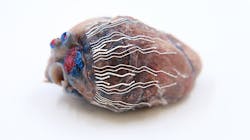Printable biosensor simultaneously records and makes images of tissues and organs
Purdue University Research Foundation News reported a new, patent-pending Purdue University biosensor, which can be printed in 3D using an automated printing system and allows for simultaneous recording and imaging of tissues and organs during a surgical operation.
The biosensor was created by Chi Hwan Lee, the Leslie A. Geddes Assistant Professor of Biomedical Engineering in the Weldon School of Biomedical Engineering and assistant professor of mechanical engineering.
"Simultaneous recording and imaging could be useful during heart surgery in localizing critical regions and guiding surgical interventions such as a procedure for restoring normal heart rhythms," Lee said.
Traditional methods to simultaneously record and image tissues and organs have proven difficult because other sensors used for recording typically interrupt the imaging process.
By using soft bio-inks during the rapid prototyping of a custom-fit design, biosensors fit a variety of sizes and shapes of an organ. The bio-inks are softer than tissue, stretch without experiencing sensor degradation and have reliable natural adhesion to the wet surface of organs without needing additional adhesives. Kwan-Soo Lee's research group in Los Alamos National Laboratory is responsible for the formulation and synthesis of the bio-inks.
A number of prototype biosensors using different shapes, sizes and configurations have been produced. Craig Goergen, the Leslie A. Geddes Associate Professor of Biomedical Engineering in Purdue's Weldon School of Biomedical Engineering, and his laboratory group have tested the prototypes in mice and pigs in vivo.
"Professor Goergen and his team were successfully able to identify the exact location of myocardial infarctions over time using the prototype biosensors," Lee said. "In addition to these tests, they also evaluated the biocompatibility and anti-biofouling properties of the biosensors, as well as the effects of the biosensors on cardiac function. They have shown no significant adverse effects.”
The growing need for the implementation of stretchable biosensors in the body has driven rapid prototyping schemes through the direct ink writing of multidimensional functional architectures. Recent approaches employ biocompatible inks that are dispensable through an automated nozzle injection system. However, their application in medical practices remains challenged in reliable recording due to their viscoelastic nature that yields mechanical and electrical hysteresis under periodic large strains. Purdue
